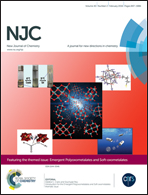Morphological tuning of Eu2O2S nanoparticles, manifestation of peroxidase-like activity and glucose assay use†
Abstract
Eu2O2S nanoparticles have been synthesized by solvothermal decomposition of the precursor complex [NHEt3]+[Eu(acda)4]−, wherein acda− is the anion of 2-aminocyclopentene-1-dithiocarboxylic acid. Oleylamine alone or in combination with surface active agents, such as trioctylphosphine or oleic acid, at 280 °C produced nanoparticles of three different morphologies, namely, ultrathin nanoplates, nanospheres and short rods. The optical band energy of the nanoparticles has been found to be 4.57(8) eV. Eu2O2S particles exhibit strong photoluminescence at room temperature with a quantum yield of about 4% upon excitation at 285 nm. All three forms display peroxidase-like activity towards the oxidation of 3,3′,5,5′-tetramethylbenzidine in the presence of H2O2 and follow a Michaelis–Menten enzymatic pathway. The mechanistic investigation reveals that the Eu3+/Eu2+ redox couple plays a crucial role behind this catalytic process. Catalytic efficiency of the nanoparticles decreases in the order plates > spheres > rod-like particles. Based on peroxidase activity, selective detection and estimation of glucose in the presence of related carbohydrates has been carried out.


 Please wait while we load your content...
Please wait while we load your content...